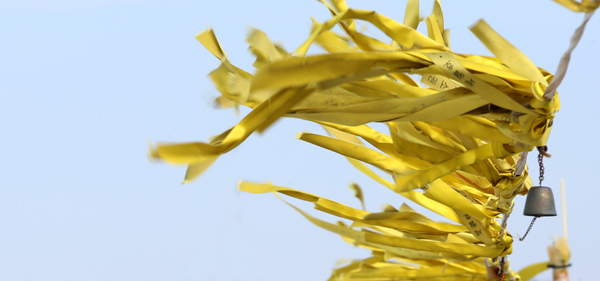Yellow ribbons spark new strife

The yellow ribbons symbolize the victims of the Sewol disaster.
Paengmok Harbor, situated in Jindo County, is the closest port to where the ferry sank and has often served as the site of rallies and demonstrations, which many times led to clashes between civilians and police.
Although the victims’ families have yet to issue a statement on the matter - they told the JoongAng Ilbo on Monday that they would discuss the matter soon - the latest news is expected to deepen the chasm between them and the authorities, as both sides have continued to lock horns over the government’s response in the aftermath of the tragedy.
Dated July 3, the letter appears to have been issued by the Jindo County Office to the Countermeasures Committee for Victims, Missing Passengers and Survivors in the Sewol Ferry Disaster, a group of local activists and the relatives of the victims.
The 4/16 Sewol Families for Truth and a Safe Society, a separate organization solely composed of family members of the victims, also claimed to have received the note and revealed the letter to the JoongAng Ilbo.
In a telephone interview with the Korea JoongAng Daily the same day, an insider from the county office adamantly denied reports that it was planning to take down the ribbons by the end of August, adding that officials are “trying to talk things out” with the families.
“How could we dare do such a thing?” the source said, adding that the office had yet to receive a response from the victims’ families concerning the suggestion to remove the ribbons.
Responding to why the office had suggested the idea in the first place, the source, as in the letter, said that the residents near Paengmok Harbor were under “immense stress” from the noise caused by the demonstrations over the ferry accident. Dwindling tourist numbers were also cited as a problem for the local economy.
The Sewol ferry accident, considered Korea’s worst maritime disaster, resulted in the deaths of more than 300 passengers on April 16, 2014, when the vessel suddenly capsized and sank in waters off Jindo County, South Jeolla.
Jindo Island is some 472 kilometers (293 miles) south of Seoul.
Only 172 people were able to flee the ferry before it completely capsized and then sank. The remaining 304 people went down with the ship.
In months of searching, the remains of 295 passengers and crew members were recovered from the shipwreck at the cost of the lives of two divers.
Nine victims remain unaccounted for.
Saturated in a sea of yellow ribbons, Paengmok Harbor has become a site symbolizing grief and sorrow, where memorial ceremonies are often organized by the family members of the victims, who claim that the government has still not done enough to launch a proper investigation into the cause of the tragedy.
BY LEE SUNG-EUN AND KIM HO [lee.sungeun@joongang.co.kr]










with the Korea JoongAng Daily
To write comments, please log in to one of the accounts.
Standards Board Policy (0/250자)